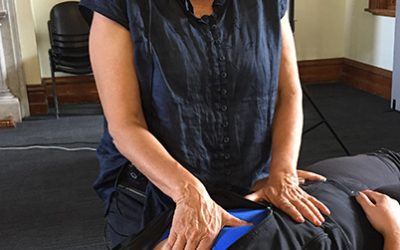Osteopathic practice is based on the premise that all functional systems interact to either produce disease or promote health.

It is well recognised among osteopaths that breathing is a function that is commonly disrupted and that this disruption can reflect a person’s health as well as their response to treatment.
Breathing: back, neck and pelvic pain
- Research has shown that breathing dysfunction is an important factor in mitigating chronic neck, lower back and pelvic pain [1-3].
- Breathing retraining combined with manual therapy has been shown to be helpful for back and neck pain that does not responded well to manual therapy and exercise rehabilitation alone [4].
Breathing: posture and structural development
- Poor breathing affects movement patterns in the neck, shoulders and reduces core stability [5].
- Breathing patterns and poor breathing habits such as mouth breathing are an important influence on postural and structural development in children [6, 7].
Manual therapy for asthma and other breathing disorders
Specific types of manual therapy can be helpful for respiratory diseases such as COPD [8] and asthma [9].
People with chronic respiratory diseases such as asthma and COPD tend to have tension in key breathing muscles that attach to and move the rib cage. They also tend to have reduced flexibility of the spine, shoulders and rib cage [10].
In my experience manual therapy can be very useful for relaxing key breathing muscles and improving rib cage mobility particularly when used in conjunction with breathing retraining.
References
- Smith M, Russell A, Hodges P. Disorders of breathing and continence have a stronger association with back pain than obesity and physical activity. Aust J Physiotherapy. 2006;52(1):11-6.
- Dimitriadis Z, Kapreli E, Strimpakos N, Oldham J. Respiratory weakness in patients with chronic neck pain. Man Ther. 2013;18(3):248-53.
- Haugstad GK, Haugstrad UM. Posture, movement patterns, and body awareness in women with chronic pelvic pain. J Psychosomatic Research. 2006;61(5):637-44.
- McLaughlin L, Goldsmith CH, Coleman K. Breathing evaluation and retraining as an adjunct to manual therapy. Man Ther. 2011;16(1):51-2.
- Bradley H, Esformes J. Breathing pattern disorders and functional movement. INternational Journal of Sports Physical Therapy. 2014;9(1):28-39.
- Peltomäki T. The effect of mode of breathing on craniofacial growth—revisited. The European Journal of Orthodontics. 2007;29(5):426-9.
- Jefferson Y. Mouth breathing: adverse effects on facial growth, health, academics, and behavior. Gen Dent. 2010;58(1):18-25.
- Engel R, Vemulpad S. The role of spinal manipulation, soft-tissue therapy, and exercise in chronic obstructive pulmonary disease: a review of the literature and proposal of an anatomical explanation. Journal of alternative and complementary medicine (New York, NY). 2011;17(9):797-801.
- Lowhagen O, Bergqvist P. Physiotherapy in asthma using the new Lotorp method. Complementary therapies in clinical practice. 2014;20(4):276-9.
- Lunardi AC, Da Silva CC, Mendes FA, Marques AP, Stelmach R, Carvalho CR. Musculoskeletal dysfunction and pain in adults with asthma. Journal of Asthma. 2011;48:105-10.
